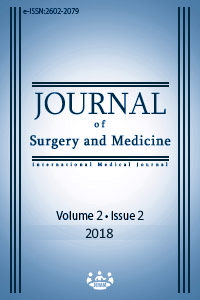Assessment of risk factors affecting thrombosis in patients with essential thrombocytosis
Keywords:
Thrombosis history, Essential thrombocytosis, Janus kinase 2 mutation, Leukocyte count, Platelet countAbstract
Aim: Arterial and venous thromboembolic complications are the leading cause of morbidity and mortality in Essential thrombocytosis (ET). The mechanism of thrombosis in ET is not fully explained. In present retrospective analysis, we aimed to investigate the association between thrombosis complication and age, gender, disease duration, laboratory findings, janus kinase 2 (JAK2) V617F mutation status in patients with ET.
Methods: Medical database of ET patients whom admitted to outpatient clinics of our institution, between April 2015 and April 2017, were retrospectively analyzed. Patients were divided into two groups, with and without arterial or venous thrombosis history. According to the thrombosis story, general characteristics, laboratory findings and JAK2 V617F mutation status of the groups were compared.
Results: 37 patients with thrombosis history and 15 patients without thrombosis history were detected. The number of leukocyte, platelet and lymphocyte in ET patients with thrombosis history was statistically significantly higher than without thrombosis history patients. JAK2 V617F mutation positivity was statistically significant in ET patients with thrombosis history.
Conclusion: This study confirmed the high leukocyte count, high platelet and lymphocyte count and JAK2 V617F mutation positivity as the thrombosis risk factor in patients with ET. In addition, the characteristics of the patients who applied to our clinic were compared with the literature and the differences were revealed.
Downloads
References
Falchi L, et al., Approach to patients with essential thrombocythaemia and very high platelet counts: what is the evidence for treatment? British Journal of Haematology. 2017; 176(3):352-64.
Tefferi A, Barbui T. Polycythemia vera and essential thrombocythemia: 2017 update on diagnosis, risk-stratification, and management. Am J Hematol. 2017;92(1):94-108.
Reikvam H, Tiu R. Venous thromboembolism in patients with essential thrombocythemia and polycythemia vera. Leukemia. 2012;26(4):563.
Marchetti M, et al. Thrombin generation and activated protein C resistance in patients with essential thrombocythemia and polycythemia vera. Blood. 2008;112(10):4061-68.
Elliott MA, Tefferi A. Thrombosis and haemorrhage in polycythaemia vera and essential thrombocythaemia. British Journal of Haematology. 2005;128(3):275-90.
McMahon B, Stein BL. Thrombotic and bleeding complications in classical myeloproliferative neoplasms. in Seminars in thrombosis and hemostasis. 2013. Thieme Medical Publishers.
Vardiman JW, et al. The 2008 revision of the World Health Organization (WHO) classification of myeloid neoplasms and acute leukemia: rationale and important changes. Blood. 2009;114(5):937-51.
Tefferi A, Barbui T. Polycythemia vera and essential thrombocythemia: 2015 update on diagnosis, risk‐stratification and management. Am J Hematol. 2015;90(2):162-73.
Tefferi A, et al. Calreticulin mutations and long-term survival in essential thrombocythemia. Leukemia. 2014;28(12):2300.
Passamonti F, et al, It is time to change thrombosis risk assessment for PV and ET? Best Practice & Research Clinical Haematology. 2014;27(2):121-7.
Buxhofer‐Ausch, V., et al., Impact of white blood cell counts at diagnosis and during follow‐up in patients with essential thrombocythaemia and prefibrotic primary myelofibrosis. British J Hematol. 2017;179(1):166-9.
Falanga, A. and M. Marchetti, Thrombotic disease in the myeloproliferative neoplasms. ASH Education Program Book. 2012; 2012(1):571-81.
Afshar-Kharghan V, Thiagarajan P. Leukocyte adhesion and thrombosis. Current Opinion Hematol. 2006;13(1):34-9.
Arellano-Rodrigo E, et al. Increased platelet and leukocyte activation as contributing mechanisms for thrombosis in essential thrombocythemia and correlation with the JAK2 mutational status. Haematologica. 2006;91(2):169-75.
Patrono C, Rocca B, Stefano V. De, Platelet activation and inhibition in polycythemia vera and essential thrombocythemia. Blood. 2013;121(10):1701-11.
Cervantes F, Arellano-Rodrigo E, Alvarez-Larrán A. Blood cell activation in myeloproliferative neoplasms. Haematologica. 2009;94(11):1484-8.
Panova‐Noeva M, et al. Platelet‐induced thrombin generation by the calibrated automated thrombogram assay is increased in patients with essential thrombocythemia and polycythemia vera. American J Hematol. 2011;86(4):337-42.
Tong D, et al., Phosphatidylserine-exposing blood and endothelial cells contribute to the hypercoagulable state in essential thrombocythemia patients. Annals Hematol. 2018;1-12.
Presseizen K, et al. Phosphatidylserine expression on the platelet membrane of patients with myeloproliferative disorders and its effect on platelet-dependent thrombin formation. Clinical and applied thrombosis/hemostasis. 2002;8(1):33-9.
Cervantes F, Passamonti F, Barosi G. Life expectancy and prognostic factors in the classic BCR/ABL-negative myeloproliferative disorders. Leukemia. 2008;22(5):905.
Bonomini M, et al. Increased platelet phosphatidylserine exposure and caspase activation in chronic uremia. Journal of Thrombosis and Haemostasis. 2004;2(8):1275-81.
Turitto V, Weiss H. Red blood cells: their dual role in thrombus formation. Science. 1980;207(4430):541-3.
Godfrey AL, et al. Clonal analyses reveal associations of JAK2V617F homozygosity with hematologic features, age and gender in polycythemia vera and essential thrombocythemia. Haematologica. 2013;98(5):718-21.
Dudler J, et al. RAISE–Rheumatoid arthritis independent Swiss treatment expectations and outcome: Results for the abatacept subpopulation. Swiss Med Wkly. 2013; 143:w13849.
Vannucchi A, et al. Clinical correlates of JAK2V617F presence or allele burden in myeloproliferative neoplasms: a critical reappraisal. Leukemia. 2008;22(7):1299.
Downloads
- 3356 3306
Published
Issue
Section
How to Cite
License
Copyright (c) 2018 Mehmet Zahid Koçak, Mehmet Dağlı, Kemal Fidan
This work is licensed under a Creative Commons Attribution-NonCommercial-NoDerivatives 4.0 International License.















